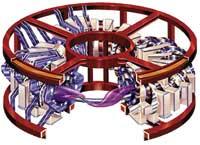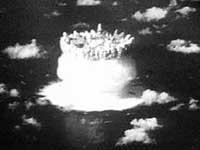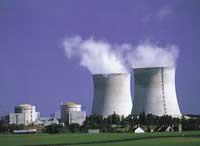Nuclear fusion: closer but far
Energy sources are, as we all know, fundamental to the development of society. In the 1970s the oil crisis aggravated Western society and intensified the development of new and old energy sources. And today, energy sources and their problems are one of the main concerns of society. From a broad classification, we can say that energy sources are of two types:
- capable of producing large amounts of energy: fission nuclear power plants and fossil fuels. Very technologically developed, very productive from the economic point of view, and that we can consider as a strong source of energy for the next two centuries, but that can or are harmful to the environment (Txernobil, radioactive waste, acid rain, greenhouse effect...)
- alternative energies, which in principle seem clean, which do not attack the environment (although in recent times wind energy has sparked debate), but which are not able to generate the enormous amount of energy needed by the structure of today's society.

In this debate on energy sources it is mentioned on several occasions that in the future we will have a virgin energy source, based on the energy emitted by the stars, infinite and clean. Despite being closer and closer, it is always far away. Yes, I mean the energy generated in nuclear fusion. Since 1952 we know that this energy can also be produced on planet Earth. Unfortunately, however, the demonstration of this coincided with the explosion of the explosive H, and this brutal demonstration has brought with it a concern that this energy is clean, or cleaner than other energies of type (i), it is no wonder that when we listen we hesitate. In the following lines I will try to analyze what nuclear fusion is and what are the difficulties in turning it into a source of energy. And above all, I will explain why nuclear fusion is clean about nuclear fission.
When two light nuclei, like hydrogen or its isotopes — deuterium and tritium — come together, energy is released into this nuclear reaction. If the nuclei are very heavy, the only way to release energy is by dividing the nuclei (nuclear fission). For the second process, i.e. for fission, a single neutron can attack and produce fission in heavy nuclei such as uranium or plutonium. For fusion we must add two nuclei that repel each other, that is, overcome the electrostatic repulsion of those two nuclei so that they are able to unify the nuclei. As we can see, the fusion process is nothing simple.
Due to the enormous mass of the stars, their gravitational attraction allows them to confine the entire mass of the star and, thanks to it, the internuclear union emits a large amount of energy into space. On planet Earth it is impossible for this type of gravitational confinement to occur, so the confinement of the nuclei must be done differently. In 1952, as mentioned above, this confinement was achieved. In it, they provoked the explosion of the fission nuclear explosive to confine the fusion fuel and the fusion reactions caused by this explosion wave released 50 times more energy than the fission explosive.
Obtaining fusion reactions, both in a controlled and uncontrolled manner, is not immediate. The first step in technology for fusion reactions that is currently being developed is obtaining electron and ion soup from the fusion fuel, plasma. Plasma is the fourth situation of matter that is not present on our planet. Although not on Earth, 99% of the matter of the universe is in plasma state. By heating a solid will become liquid and will volatilize, making it hotter, to gas. If we continue to heat, reaching the temperature of 11,000 (which indicates that the average kinetic energy of the internal particles of the plasma is 1 eV), the gas atoms begin to lose electrons, becoming a soup formed by negative electrons and positive ions.

However, in this situation there will not yet be a fusion reaction, as there is a repulsion force between positive ions. But if the plasma is heated more, these ions or cores can reach a high speed (kinetic energy), which can make the repulsive force unable to prevent internuclear shocks. Experimentally it is proven that this is possible, but for this the plasma temperature must be enormous, with a minimum of 100 million degrees (10 keV). At this temperature you can start to produce fusion reactions, but it is not enough for a few to produce, since the energy used to reach that temperature has been enormous. The most convenient thing is that the number of fusion reactions per unit of time is high. Therefore, for the probability of a fusion reaction to occur to be high, plasma density must also be high. However, the fusion reaction of (1) that is being experienced for future reactors, already obtained in fusion laboratories, is not a sufficient condition to consider fusion as a new energy source.
As we are seeing, the energy absorbed by fusion is very large and, of course, the energy obtained in fusion in a fusion plant must be much greater than the energy consumed. On the other hand, we know that any hot body, submerged in a colder medium, will quickly cool down by atomic diffusion or dispersion. This process can be very serious in the case of plasma. Therefore, in some way it is necessary to confine the plasma to keep the plasma warm, that is, so that no such atomic dispersion occurs. Because fusion plasma must be so hot (above 100 million degrees), confinement is not possible, as in bottles, by using walls. These bottles cannot contain physical walls.
Instead magnetic confinement is used, that is, the wall is formed by the lines of the magnetic field. Field lines must confine charged particles (electrons and ions) that move rapidly within the plasma in a closed donut region to obtain a profitable fusion energy. The problem of confinement is nothing simple and the technology used today is the TOKAMAS concept, developed by Russian scientists. This defines the time of confinement, indicating the time that the hot plasma remains hot without external energy supply.
The use of fusion reactions is limited by three parameters: plasma temperature, density and confinement time. The product of these three substances is called the fusion parameter. The value of the fusion parameter has long been calculated for the fusion reactor to be used as an energy source. Lawson calculated in 1957 that the value of the fusion parameter must exceed 5x1021 m-3keVs (Lawson's criterion) so that the energy cycle yield is 35%. When one manages to keep the plasma under Lawson's criterion without heating it externally, one can say that the point of ignatius has been achieved.

The current plasmas are far from this point and the other very important parameter that is used is that of the energy gain, that is, the reason between the energy generated by the fusion and the energy used to reach the fusion, the so-called factor Q. When Q=1 the energy generated in the fusion will be the same as the energy produced to reach it and at this point it is called "break-even". Obviously, in order for the fusion reactor to be competitive in the market we would have to get Q>>1. And one of the problems to achieve this is that to produce, heat and confine plasma a great use of energy is necessary.
The experiments of this generation pursue a situation around the "break-even", of which we can say that they are very close, Q = 0.9 has been overcome. Plasma is expected in ignition conditions in next generation reactors. To do this, the ITER (International Thermonuclear Experimental Reactor) project is already underway, involving the European Union, Russia, Japan and the United States. This same year, and within the established period, the design of the internal reactor has been completed and the location of this experimental reactor, which is the case in Europe and Japan, will be decided immediately. I have written above that the participants of the ITER project were four, but now they are three, because two months ago the United States has abandoned the project. There may be many reasons, but according to rumors from scientists working there, the reason lies in the lack of leadership of fusion technology in the United States and the inability to locate the reactor.
It should be noted that with the reactors of this generation the parameters that would be required for ignition have been obtained independently, but all together, at the same time, so that ignition is not achieved. Temperatures of 400 million degrees, 1021 particles/m3 and confinement times of more than one second have been reached. And in 1997 at the European Union's JET reactor, located in Edinburgh, a fusion power of 16 MW was achieved, the highest power achieved to date. In addition, it should be mentioned that this power was obtained in a plasma deuterium + tritium and not in the plasma of deuterium + deuterium designed in JET. However, it is true that fusion plasma has not yet been obtained in stable conditions. And we don't know how this type of plasma will act (it's the biggest scientific concern).
Not knowing this, the engineering problems that the stable plasma will generate will also not be small. If the development is maintained as expected, the reactor that will be built in the ITER project will obtain plasmas of ignitical conditions, that is, stable, and after its research and dominion, in the next phase will be built a reactor for the DEMO test, which will adapt to the needs of a real power plant. The time to hook the fusion reactor to the power grid, if things go as planned, will pass within 40 years. Although this period seems very long, in the 1980s it is shorter than expected. However, keep in mind that what you want to do is "build a star in the laboratory", and from this perspective, are the aforementioned deadlines long?

Suppose a fusion reactor can and is achieved (that of magnetic confinement). Let's look at the advantages and disadvantages of current energy sources. The main drawback is the cost. The initial investment for fusion reactors will be enormous (research is also being carried out internationally), much higher than any current energy source needs. This will be a huge barrier to current fossil fuel and nuclear fission plants. In addition, it is known that the last two energy sources can produce energy without problems (technological) and at low cost.
As for the advantages, the first is that of fuel. Deuterium, widespread in the sea and rivers, is cheap and has no danger of being exhausted. The second advantage refers to the safety of future fusion reactors; the interruption of fuel in fusion reactions prevents the fusion reaction, in addition to the fact that in fusion reactors with magnetic confinement the fuel is regularly produced, so the fusion reactor is impossible to escape from the hands, that is, contrary to what happens in fission plants (case of Txernobil), the "de-collision" in reactors. Therefore, the fusion reactor has no risk of explosion or fusion.
Just as fusion advocates sell, cleaning is another obvious advantage. Fission nuclear power plants and fossil fuel power plants can damage the environment for centuries. The events that took place at the Chernobyl and Harrisburg fission nuclear power plants, radioactive waste (a topic that today is in full swing, what to do with them? ), greenhouse effect, acid rain... Fusion reactors, for their part, consider that they cannot cause such damage. I will briefly analyze what this means in the following lines, comparing them with the fission reactions.
Nuclear fission reactions produce more than 200 radioisotopes. Many also have thousands of years of life. For example, a well-known plutonium isotope has an average life of 24,000 years (and is not the longest). Given the high amount of radioisotopes generated in the fission reaction, its treatment and use is very difficult, practically impossible. For this reason, the Italian Nobel Prize winner Carlo Rubbia has just proposed that the thorium be fissured with an accelerator so that the number of types of nuclear waste is much lower and easier to treat. In the case of nuclear fusion, the only particles generated according to the equation (1) are alpha particles (helium atoms) and high-energy neutrons. Helium, called melting dust, is one of the most widespread stable atoms in the universe.

Alpha particles have great importance in the maintenance of hot plasma and being ionized (like alpha particles) confine magnetic fields. Neutrons (1) are also formed in reaction, which can escape from the confinement region by colliding with the rich layer that delimits the plasma. The rich layer delimits the confinement region and is built with lithium or lithium compounds. The rich layer has two functions: i) that the neutrons collide with the lithium atoms creating tritium, fuel for the plasma, and ii) that absorbs the great kinetic energy of the generated neutrons, to convert them into electric energy. Therefore, in the fusion reactor radioactivity is not found in the fusion reaction (there are no residues), but in the transmutations produced by the collision of neutrons with medium materials.
The consequences of transmutations are of two types: 1) beneficial for the fusion reaction process, generating tritium fuel and 2) harmful from all points of view. The latter depends on the materials used in the structure of magnetic confinement. Using appropriate low-nuclear materials, the activity generated by neutrons in these materials can be reduced up to 10 million times when stopping the reactor without generating long-term waste. These waste would remain inside the plant without escape to the outside.
However, it should not be forgotten that although the selected materials are suitable, they present impurities that can lead to long-term waste. On the other hand, tritium fuel is a radioactive isotope of 12.3 years of average life, a simple beta-particle emitter, whose average electron emission energy is 5.7 KeV. Since tritium is gas, in a serious accident it can escape magnetic confinement. Forecasts of the degree of radioactivity that the population could suffer in the surroundings of the plants, even in the most serious accident that could occur, and the tritium leaks of a future fusion reactor, indicate that, in the worst case, the level of main radioactivity would be located 1 km from the plant.
By associating fusion reactors to the power grid, if they are associated at some point, it can be said that an inexhaustible source of energy will be obtained with all that this implies. They will be much cleaner than fossil fuel and nuclear fission plants. They will not be able to cause damage of centuries, but neither will they have virgin purity. However, unlike other plants, where adverse effects are intrinsic to the process, fusion reactors can improve the degree of cleanliness.
American route
The merger program described in the article, corresponding to the ITER project, is not the only one to achieve the merger. Another way is that of inertial confinement, which is developing especially in the United States and which has little development in Europe, since for inertial confinement power lasers are needed, which being secret technologies (behind which there is military interest), are not published, so the research carried out is kept secret.

In the United States, this type of research is being carried out at the Lawrence Livermoore Laboratory, a laboratory of various military secrets, and it is known that 60 high-power lasers work with the aim of achieving fusion and that by 2003 200 power lasers will be built.
In this case, unlike magnetic confinement, confinement times should be very short, around a nanosecond. Therefore, according to Lawson's criterion, plasmas must be very dense in order to benefit from these reactors. The physical concept of fusion is also easy to understand in this case, since to a ball of a few millimeters of diameter that carries fuel inside the lasers of power attack in the most homogeneous way possible reducing the radius of the ball so that the fusion between the cores occurs. However, unlike magnetic confinement, in the case of inertial confinement it is not known to what extent the fusion pathway has been broken, at what value is the fusion parameter? is "break-even" near or far? Researchers do not answer these questions, as research is done in secret.





